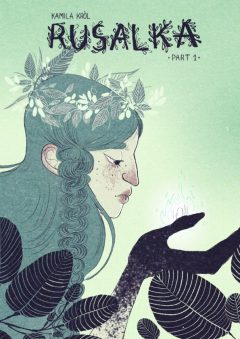Review: Rusalka Part One (Kamila Krol)
Joining the likes of Alexander Utkin’s Gamayun Tales, as a book inspired by Slavic folktales, Kamila Krol’s Rusalka is beautiful and dreamlike look at the origins of a Polish water demon. But will this be another timeless classic or a damp squib?
 Publisher: Kamila Krol
Publisher: Kamila Krol
Writer: Kamila Krol
Artist: Kamila Krol
Price: TBC from pigeonmakesart Etsy Store
Rusalka was inspired by Kamila’s own Polish heritage. In the notes at the back of the book she explains how she was inspired to develop the tale of the mysterious Rusalka thanks to her fascination with the demonic women in Slavic folktales. She also looked to shift the point of view of the story and concentrate on the tragic origin of the character, who normally appears fully formed. As such we get this wonderful mix of dreamlike folky imagery, along with a surreal almost fantasy-like origin story for this elusive character.
As a piece of visual story telling Rusalka is truly exceptional. As well as the aforementioned Gamayun Tales, it reminded us a lot of Raze by Clare Spiller (which is no surprise given their Welsh connection) with it’s mixture of magical folkloric characters and dreamlike worlds. However unlike the more cartoonish approach of Spiller’s work it has this much more illustrative style. It has this flowing textured, almost liquid style that sees element flow throughout the panels of the page. It’s part illustration, part pre-raphelite painting. All of this perfectly compliments the aquatic theme of the character, and it even feels like it has the flow of an aquatic Studio Ghibli animation like Ponyo at times as well. The pages could literally be dripping it feels so fluid!
 The page designs are both gloriously free formed, but also wonderfully constructed. While the green colour schemes gives it this gloriously organic, aquatic tone to it, feeling both watery and leafy at the same time. This textural quality is amplified by halftone texture through out, which rather than evoke memories of cheap newsprint, gives everything a very contemporary textural feel to the pages. While we read this digitally it feels like it could be very special indeed if read in print form.
The page designs are both gloriously free formed, but also wonderfully constructed. While the green colour schemes gives it this gloriously organic, aquatic tone to it, feeling both watery and leafy at the same time. This textural quality is amplified by halftone texture through out, which rather than evoke memories of cheap newsprint, gives everything a very contemporary textural feel to the pages. While we read this digitally it feels like it could be very special indeed if read in print form.
While the story itself is a little esoteric and lightweight, the shift of perspective is an interesting one. We are so used to a third person’s narrative in a story like this, that having it from the perspective of Rusalka makes for an interesting and disorientating approach as she attempts to figure out what is happening. While this does gives the story a slightly rambling feel to it, the truly jaw dropping visuals and the dreamlike nature of the story allow it to become an almost hallucinatory experience rather than a straight story and so any shortcoming are soon lost as you immerse yourself in every page. In fact, this vagueness actually goes really well with the uncertain folkloric concept of this origin story.
Rusalka is a truly wonderful read and one of those books which you find yourself immersing yourself in rather than simple reading it. While the story is not the most in depth, this is a comic which is as much about the use of images to convey mood and feelings as it is to tell a formal story. Kamila manages to do this expertly and this is a very special read. We hope this will the first of many books in this series, and from this creator, as this is one of the most exciting and inspiring debuts we have read in a long time.



October 22, 2025 @ 10:56 am
Can you be more specific about the content of your article? After reading it, I still have some doubts. Hope you can help me.